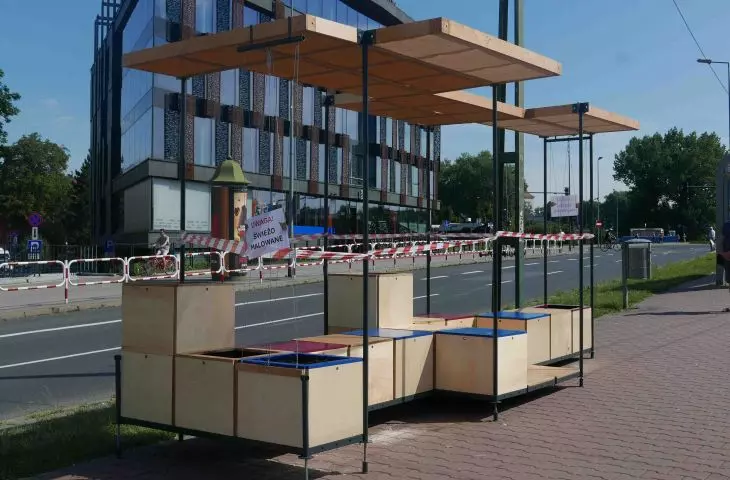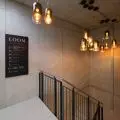It's hot in Krakow not only because of the heat pouring down from the sky - in recent days emotions have been heated up by the discussion of "cooling corners," i.e. wooden structures to appear on Krakow bus stops as a result of the city's joining the CoolCo's pilot program. What is the controversial shelters all about?
The urban heat island phenomenon continues unabated, and every summer the Internet iconosphere is flooded with memes and infographics drawing attention to overheating concrete surfaces in citiescities and the temperature differences that exist between exposed, sunny areas and areas hidden in shade and bathed in vegetation. City officials are trying to combat urban heat islands in a variety of ways - new parks are being established in cities, car traffic is being reduced, and the amount of non-heating low greenery and shade-giving trees is being increased instead. However, these are measures that require time, proper planning, a lot of work and considerable financial resources. But can the phenomenon of the urban heat island be fought in a more immediate way?
Cooling shelters in Krakow - CoolCo's
Photo: Przemyslaw Ciępka
cooling corners
Theanswer to this question seems to be provided by Zsófia Anna Ghira and Anna Imola Pápay-Langmár, authors of the CoolCo's project, which is being implemented as part of the New European Bauhaus, an initiative aimed at improving living conditions and the quality of space offered by European cities. The concept is based on creating ephemeral small architecture from a set of modular elements developed by the authors. The resulting structures are shelters with geometrized forms, intended to provide a shady place to sit, so much needed in the concreted centers of cities. Pots are incorporated into the shaping blocks of the shelters - the plants planted in them are intended to further reduce the temperature within the cooling shelter, additionally providing a friendly habitat for insects and birds. The structure is largely made of plywood and a metal frame. The first "cooling corner" stood in Budapest last July - its installation was preceded by public consultations, which are one of the important elements of the initiative. In 2024, other European cities joined the pilot project, including Krakow - what reactions did the cooling bus shelters evoke in the capital of Malopolska?
Cooling bus shelters in Krakow - CoolCo's
Photo: Przemyslaw Ciępka
a shelter in the krakow style
A few days ago, information about "strange structures" appearing in the center of Cracow cooled in the Polish media. These are CoolCo's cooling shelters, which Krakow's Public Transport Authority intends to set up at the sunniest stops - the first of which has already been erected near the Grunwaldzkie Roundabout. The constructions immediately aroused considerable controversy among Internet users - attention is drawn primarily to the waste of public money, afunctionality, ill-considered location and aesthetic dimension of the implementation , which is compared to a vegetable or lemonade stand.
Krakow's ZTP responded to the allegations:
Some facts about the CoolCo's project in Krakow PL:
- the city does not incur any costs (the project is 100% financed with €20,000 from the European Commission),
- the city, as a partner in this project, only provides the space for conducting the pilot,
- the city does not consider this as a substitute for trees,
- the city decided to carry out this PILOT because it gave us an additional few square meters of canopy for KMK passengers on hot days at important interchanges.
Whilemany of the objections can be agreed with, it should be noted that we are dealing with a pilot implementation, so it's worth considering what went wrong in Krakow's shelters and how it can be remedied - especially since Budapest's pioneering "cooling island" received a positive response.
Cooling shelters in Krakow - CoolCo's
Photo: Przemyslaw Ciępka
the devil is in the details
Unfortunately, the first observation that comes to mind after direct contact with the facility is...the lack of the promised shade. The shelters were intended to provide shade for most of the day for those using them - when measured under the Budapest shelter, it was as much as 20 degrees Celsius less than in the surrounding, concreted space. The reasons for the failure of the Krakow implementation are probably manifold. Above all, planning errors were at fault - the shelter at the Grunwald Roundabout is oriented at the wrong angle, and its canopy has a polygonal outline, seeming to reflect the location of the seats offered by the facility. Such a solution may have a positive effect on the aesthetic dimension of the shelter, but it prevents it from fulfilling its primary task, as the final area of shadow cast by the canopy is significantly reduced. The standing structure in Budapest was covered with an uncomplicated rectangular-shaped canopy, which performs its task better.
Cooling shelters in Krakow - CoolCo's
Photo: Przemyslaw Ciępka
In terms of aesthetics, it is important to note the state of the Krakow shelters, which are not yet completed. Some of the wooden boxes that build it have recently been painted, and filling the built-in pots with plants will certainly benefit its appearance. What is surprising is the location of the structure, which currently clutters the bus stop area rather than providing a coveted resting place. There have been permanently installed pergolas at the Grunwaldzkie Roundabout for several years, which are currently devoid of vegetation - perhaps they should be dealt with first, and the shelter should be moved to another location, where the structure will serve its purpose without giving the impression of being placed haphazardly.
Cooling shelters in Krakow - CoolCo's
Photo: Przemyslaw Ciępka
lesson for the future
It's hard to say unequivocally that any steps to combat heat waves in cities are a bad thing. The basic premise of CoolCo's project is an innovative response to the heat waves plaguing city centers. The cooling corners are erected from low-cost, biodegradable or easily reusable materials, and their lightweight and modular nature allows the structures to be easily adapted to different spaces. Unfortunately, the bus shelter that stood at the Grunwald Roundabout is an example of how inadequate planning can be counterproductive. It is to be hoped that Krakow's ZTP will learn from the unsuccessful implementation, and the next bus shelter will be assembled and located in a more thoughtful manner.






























